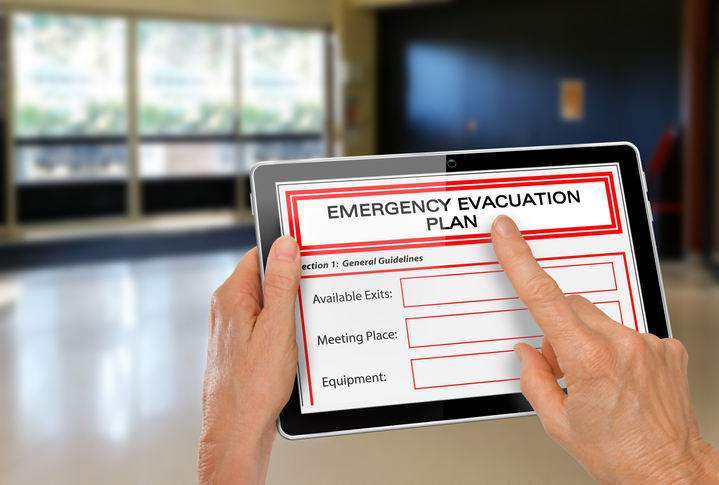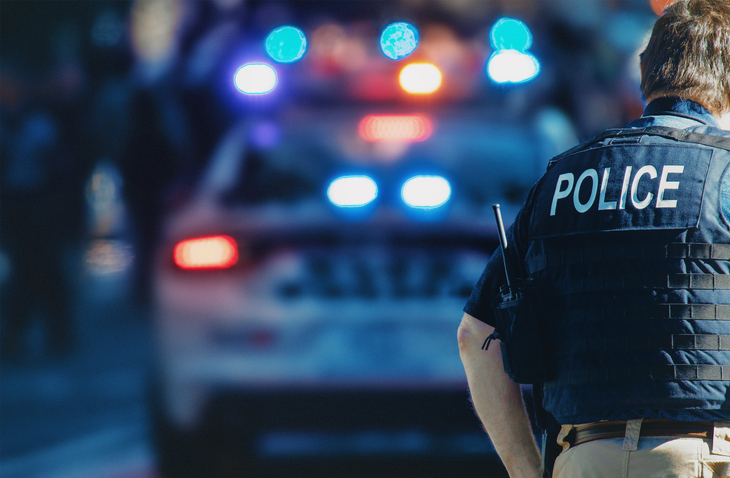Are You Prepared for an Active Shooter Incident?
Posted:
4 years, 1 month
ago
(0 comments)
Recently, I was invited to an 'Active Shooter' training with Iron Fish Distillery led by Deputy Michael Makowski of Grand Traverse County Sheriff's Office. You may be wondering, 'why would we be doing active shooter training in Northern Michigan?'. Active shooter risk is a very unfortunate reality in America which has led many businesses to prepare their teams for crisis management and response. This is great way to introduce this growing risk to businesses, how they can prepare for it and protection for the response to an active shooter event.
What is an Active Shooter Event?
U.S. Homeland Security defines an active shooter as "an individual actively engaged in killing or attempting to kill people in a confined and populated area; in most cases, active shooters use firearm(s) and there is no pattern or method to their selection of victims." Because active shooter situations are often over within 10 to 15 minutes—before law enforcement arrives on the scene—individuals must be prepared both mentally and physically to respond to an active shooter situation.
Even if the company is able to resume its operations after an active shooter incident, recovery can take an extensive amount of time. To recover from a shooting, organizations should make continuity planning, personnel issues and communication strategies top priorities. In this guide, we’ll share recommendations from experts about what organizations can do to prepare for and recover from an active shooter incident.
Training Your Staff for an Active Shooter Situation
Active shooter incidents are often unpredictable and evolve quickly. Anyone can play an integral role in the midst of the chaos to mitigate the impacts and limit the loss of life. To best prepare your staff for an active shooter situation, you can begin by creating an Emergency Action Plan (EAP) and conduct training exercises with your team.
Components of an Emergency Action Plan (EAP)
When creating an EAP, it is important to do so with input from several key stakeholders. These individuals should include (but not limited to) owners, managers, your HR department, and local emergency responders. An effective EAP includes the following:
- A preferred method for reporting fires and other emergencies
- An evacuation policy and procedure
- Emergency escape procedures and route assignments (e.g., floor plans or safe areas)
- Contact information for, and responsibilities of, individuals to be contacted under the EAP
- Information concerning local area hospitals (e.g., the name, telephone number and distance from your location)
- An emergency notification system to alert various parties of an emergency including the following:
- Individuals at remote locations within the premises
- Local law enforcement
- Local area hospitals
|
Components of Training Exercises
The most effective way to train your staff to respond to an active shooter situation is to conduct mock active shooter training exercises. Local law enforcement is an excellent resource in designing training exercises. Training components may include the following:
- Recognizing the sound of gunshots
- Reacting quickly when gunshots are heard and/or when a shooting is witnessed:
- Evacuating the area
- Hiding out
- Acting against the shooter as a last resort
- Calling 911
- Reacting when law enforcement arrives
- Adopting the survival mindset during times of crisis
|
Preparing For and Managing an Active Shooter Situation

The key stakeholders you've chosen to spearhead the EAP and training should be engaged in all planning for emergency situations, including workplace violence or an active shooter. This planning for emergency situations will help to mitigate the likelihood of an incident by establishing the mechanisms described below:
- Ensure your facility has at least two evacuation routes.
- Post evacuation routes in conspicuous locations throughout your facility.
- Include local law enforcement and first responders during training exercises.
- Encourage law enforcement, emergency responders, SWAT teams, K-9 teams and bomb squads to train for an active shooter scenario at your location.
Human Resources' Responsibilities
The following are responsibilities of HR professionals:
- Conduct effective employee screening and background checks.
- Create a system for reporting signs of potentially violent behavior.
- Make counseling services available to employees.
- Develop an EAP which includes policies and procedures for dealing with an active shooter situation, as well as after action planning.
- Make counseling services available to employees.
- Develop an EAP which includes policies and procedures for dealing with an active shooter situation, as well as after action planning.
|
Facility Manager Responsibilities
The following are responsibilities of facility mangers:
- Institute access controls (e.g., keys and security system passcodes).
- Distribute critical items to appropriate managers and employees, including floor plans, keys, facility personnel lists and telephone numbers
- Coordinate with the facility’s security department to ensure the physical security of the location.
- Assemble crisis kits containing radios, floor plans, staff roster and emergency contact numbers, First-aid kits, flashlights
- Place removable floor plans near entrances and exits for emergency responders.
- Activate the emergency notification system (if available) when an emergency situation occurs.
|
How to Respond When an Active Shooter is in Your Vicinity
Quickly determine the most reasonable way to protect your own life. Remember that customers and clients are likely to follow the lead of employees and managers during an active shooter situation.
- Be aware of your environment and any possible dangers.
- Take note of the two nearest exits in any facility you visit.
- If you are in an office, stay there and secure the door.
- If you are in a hallway, get into a room and secure the door.
- As a last resort, attempt to take the active shooter down. When the shooter is at close range and you cannot flee, your chance of survival is much greater if you try to incapacitate him or her.
- Call 911 when it is safe to do so.
1. Evacuate
If there is an accessible escape path, attempt to evacuate the premises:
- Have an escape route and plan in mind.
- Evacuate regardless of whether others agree to follow.
- Leave your belongings behind.
- Help others escape, if possible.
- Prevent individuals from entering an area where the active shooter may be.
- Keep your hands visible so the shooter does not see you as an immediate threat.
- Follow the instructions of any police officers.
- Do not attempt to move wounded people.
- Call 911 when you are safe.
2. Hide Out
If evacuation is not possible, find a place to hide where the active shooter is less likely to find you. Your hiding place should have the following characteristics:
- Be out of the active shooter’s view
- Provide protection if shots are fired in your direction (e.g., an office with a closed and locked door)
- Not trap you or restrict your options for movement
You should also take some basic steps to prevent a shooter from noticing your presence or entering your hiding place:
- Lock any doors, if possible.
- Blockade the door with heavy furniture.
3. Take action against the active shooter
As a last resort, and only when your life is in imminent danger, attempt to disrupt and/or incapacitate the active shooter by doing the following:
- Acting as aggressively as possible against him or her
- Throwing items and improvising weapons
- Yelling
- Committing to your actions
|
How to Respond When Law Enforcement Arrives
Law enforcement’s purpose is to stop the active shooter as soon as possible. Officers will proceed directly to the area in which the last shots were heard:
- Officers usually arrive in teams of four.
- Officers may wear regular patrol uniforms or external bulletproof vests, Kevlar helmets and other tactical equipment.
- Officers may be armed with rifles, shotguns or handguns.
- Officers may use pepper spray or tear gas to control the situation.
- Officers may shout commands and may push individuals to the ground for their safety.
When law enforcement arrives, do the following:
- Remain calm, and follow officers’ instructions.
- Put down any items in your hands (e.g., bags or jackets).
- Immediately raise your hands and spread your fingers.
- Keep your hands visible at all times.
- Avoid making quick movements toward officers, such as holding on to them for safety.
- Avoid pointing, screaming or yelling.
- Do not stop to ask officers for help or direction when evacuating, just proceed in the direction from which officers are entering the premises.
Provide the following information to law enforcement or the 911 operator:
- Location of the active shooter
- Number of shooters, if there is more than one
- Physical description of the shooter(s)
- Number and type of weapons held by the shooter(s)
- Number of potential victims at the location
The first officers to arrive to the scene will not stop to help injured persons. Instead, expect rescue teams comprised of additional officers and emergency medical personnel to follow the initial officers. These rescue teams will treat and remove any injured persons. They may also call upon able-bodied individuals to assist in removing the wounded from the premises.
Once you have reached a safe location or an assembly point, you will likely be held in that area by law enforcement until the situation is under control and all witnesses have been identified and questioned. Do not leave until law enforcement authorities have instructed you to do so.

|
What Next?
There is no easy way to put it, this is heavy stuff! However, you and your business can begin today by creating a plan and keeping some of these tips top of mind in the event of an active shooter or workplace violence situation. Gather up your key stakeholders and reach out to your local law enforcement to get started. Deputy Makowski along with other law enforcement are here to protect our communities. They encourage businesses and organizations to be proactive and prepared for all emergencies. For more articles and posters to safeguard your business, your employees and your customers, contact your partners at Top O' Michigan Insurance Solutions.

This Blog/Web Site does not provide insurance or legal advice. This site is for educational purposes only as well as to provide you with general information and a general understanding of insurance, not to provide specific legal advice or specific contract advice. Viewing this site, receipt of information contained on this site, or the transmission of information from or to this site does not constitute a client relationship.
The information on this Blog/Web Site is not intended to be a substitute for professional insurance or legal advice. Always seek the advice of a licensed agent in your state pertaining to insurance and legal issues.
Sources: Zywave, Wikipedia, Insurance Business Magazine, CyberSecurity & Infrastructure Security Agency
Provided by Top O' Michigan Insurance
This Risk Insights is not intended to be exhaustive nor should any discussion or opinions be construed as legal advice. Readers should contact legal counsel or an insurance professional for appropriate advice. © 2015 Zywave, Inc. All rights reserved.
Share on Facebook




Comments
There are currently no comments
New Comment